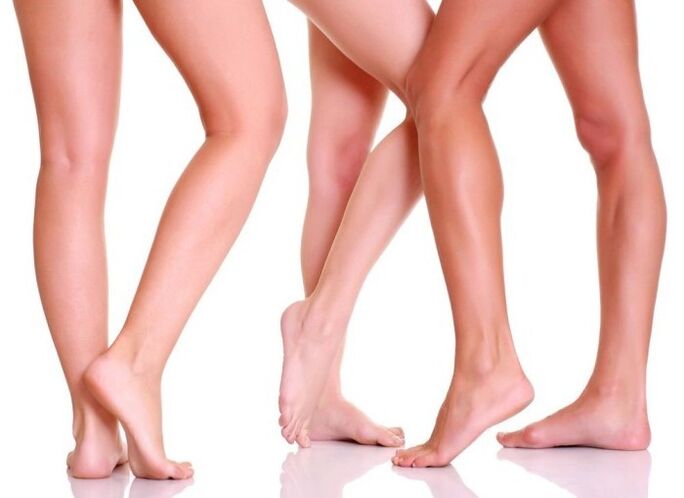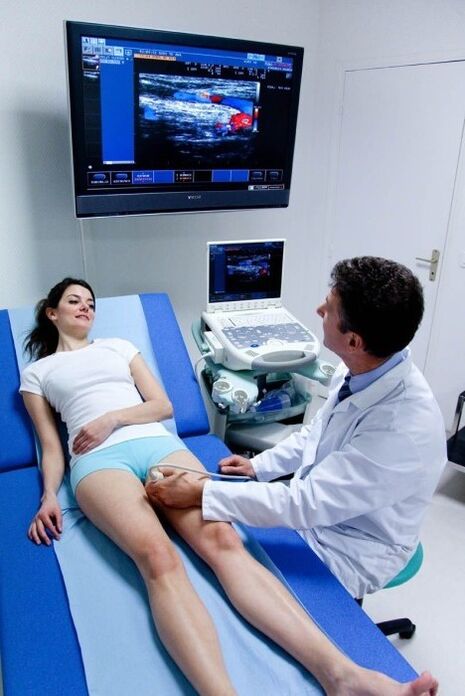Thanks to the veins, blood in the human body flows to the heart. Varicose veins of the lower extremities cause the veins to dilate and lengthen. This disease is widespread today. Women aged 30 to 40 suffer the most. Let's take a closer look at why varicose veins appear on the legs, how they are diagnosed and treated.

Why does the disease develop?
Varicose veins of the lower extremities develop gradually. This is facilitated by various unfavorable factors for the veins, which become noticeable over time in the form of the formation of nodules and networks.
Reasons why varicose veins appear on the legs:
- obesity;
- The intestines cannot cope with its work, which is why constipation often occurs;
- Flat feet;
- High blood pressure;
- Passive lifestyle;
- Great physical activity;
- Persistent tension in the legs.
Being overweight puts a lot of strain on the legs, which leads to blood congestion in the veins. In addition, when the intestines malfunction, the functioning of all organs and systems of the human body is disrupted. This is because the blood travels a long way before it flows back from the lower extremities to the heart. And when the intestines work intermittently, the venous blood cannot return up, causing stagnation in the legs.
In addition to the factors described above, the development of the disease is also promoted by diseases of the pelvic organs and hormonal imbalances caused by pregnancy, stress, antibiotics, alcohol and smoking.
Varicose veins of the lower extremities are inherited genetically. Because it is transmitted by parents, children can suffer from varicose veins at a young age. Therefore, it is important to carry out disease prevention that will help prevent the disease and prevent the development of serious complications.
Symptoms and diagnosis of the disease
The main symptoms of varicose veins of the legs are as follows:
- swelling of the legs at the end of the working day;
- Feeling of fullness and heaviness in the calf area after sitting or standing in one place for a long time;
- tingling in legs;
- The appearance of cyanosis of the legs;
- Formation of nets and stars on the legs.
If these symptoms occur, it is important to urgently consult a phlebologist or vascular surgeon. If you start treatment on time, you can prevent the development of complications.

The specialist will carefully examine the patient and listen to the complaints. He will also prescribe all tests and undergo the necessary examinations. In order to accurately diagnose and prescribe the correct and effective treatment, the doctor prescribes the following studies:
- Ultrasound examination of veins, so-called duplex vein scanning. Thanks to ultrasound, an experienced specialist can determine the state of patency of the veins, as well as their expansion. In addition, such an examination will tell you whether there are blood clots in the veins and in which direction the blood flows;
- Varicose veins in the lower extremities can be accurately diagnosed using contrast venography. Thanks to venography, the condition of the veins is assessed and the presence of blood clots and tumors is determined. During this examination, a substance is injected into the leg area, which turns the blood blue and allows the patient's veins to be imprinted on an X-ray.
The most common method for vein examination is duplex scanning.
When you should urgently see a doctor
Since varicose veins pose a danger to the human body, it is important to seek urgent medical attention in the following situations:
- If severe and stabbing pain occurs in the legs with every movement;
- If you feel a sharp pain in your leg when you get up in the morning. In this case, the leg looks swollen and dense and the skin burns;
- If, in addition to pain, there is weakness throughout the body, shortness of breath and a constant feeling of lack of oxygen;
- When the leg affected by varicose veins begins to secrete blood.
The above symptoms force a person to immediately seek medical attention to avoid unwanted dire consequences.
Treat varicose veins correctly
Taking into account the advanced stage of the disease, any complications associated with varicose veins, as well as the patient's age, the doctor prescribes conservative or surgical treatment.
Varicose veins are treated using the following methods:
- Treatment of the disease without surgery. This treatment method is only effective for the first symptoms of varicose veins. Conservative treatment methods include wearing special compression clothing, following a special diet and regularly engaging in a range of physical activities.
On the advice of a doctor, you can choose special knee-highs or socks with a certain compression for your feet. You can also wrap your legs with elastic compression bandages. Such underwear should be worn throughout the day and only taken off before going to bed.
A special massage is also useful, which is carried out with special cuffs filled with air. Thanks to pneumomassage, blood circulation improves, the tissues breathe better, pain and discomfort associated with varicose veins disappear;
- Treatment of varicose veins of the lower extremities is also carried out with the help of medications, which in turn are divided into venotonics, anticoagulants and non-steroidal anti-inflammatory drugs.
Anticoagulants prevent blood clots from forming in the veins.
Thanks to non-steroidal anti-inflammatory drugs, inflammation and pain are eliminated.
- Varicose veins are also treated with leeches. Leeches bite the skin, burrow in and release hirudin, which thins the blood and prevents blood clots from forming;
- Treatment with sclerotherapy, in which the affected veins are completely removed. The procedure goes like this. The doctor injects a special medication into the vein that clogs the veins and prevents blood flow. Because of this, damage to the veins occurs. The vein completely heals within a year. This procedure does not affect blood circulation. To completely cure varicose veins with sclerotherapy, you need to undergo three to six such sessions.
- Varicose veins are also treated with laser. The procedure is carried out under local anesthesia. The first results will be visible within three weeks after such treatment;
- If the conservative methods described above do not bring results, the doctor resorts to surgical treatment. On the second day after the operation, the patient can already walk independently.
Which method to treat varicose veins should be used in your case should be determined individually by the doctor. There is no need to self-medicate such a serious illness.
expert advice
Doctors advise all patients who come to them with varicose veins to:
- Try to drink more than two liters of purified water daily. Water helps you lose excess weight and prevents the development of varicose veins;
- It is important to have a fasting day once a week. On this day you must fast. A one-day fast helps cleanse the body of waste and toxins.
- Try to quit smoking. Ultimately, nicotine has a negative effect on blood vessels and leads to the development of varicose veins.
- Try not to overheat and strengthen your immune system so as not to get sick. Don't sit in a hot bath or sauna for too long;
- It is not recommended to suddenly change the climate. Therefore, it is best to relax in your own climate zone.
The simple tips listed will help prevent varicose veins and also make it easier to tolerate if the disease has already affected your legs.
Varicose veins and traditional medicine
It is necessary to start treating varicose veins with folk recipes only after consulting a doctor and in parallel with a conservative method of treatment. Traditional medicine recipes that help get rid of the disease:
- Mix one part minced white garlic with two parts creamed butter. Apply the resulting product to the damaged veins, wrap your leg with parchment paper and a bandage or warm scarf. This compress is done at night. Wash up in the morning and put on warm pants;
- For a year, tie green tomato slices to the affected veins before bedtime. Thanks to the vegetable, varicose veins become softer and smaller. And after a while they will disappear altogether;
- Mix sour milk with wormwood. Place the resulting mixture on a bandage and wrap it around your legs. The procedure is performed overnight;
- To prevent your legs from hurting at night due to varicose veins, you need to eat the following apple porridge. Pour one liter of boiling water over three Antonovka apples and let it steep for three hours. Then take out the apples and make them into a puree that should be consumed twice a day, 30 grams;
- Pour boiling water over 30 grams of nettle and let it steep for an hour. Then strain and drink a quarter glass three times a day. Drink for 1 month, then take a break for two weeks and repeat the course. Nettle treatment should be carried out for six months;
- Pour boiling water over the hop cones and let them steep for 15 minutes. Drink the tincture half an hour before meals. For faster results, moisten the bandages with the intoxicating infusion and apply to the affected veins;
- Pour boiling water over 5 grams of chopped nutmeg. Add 5 grams of honey and stir. Let it steep for 30 minutes. Drink 60 minutes before your morning meal and two hours after. Since nutmegs are poisonous, you should not drink more than five grams per day. Failure to heed this warning could result in death;
- Place the Kalanchoe leaves in a liter jar. Half leaves and half alcohol. Let it steep in the dark for two weeks. Shake the jar every day. Lubricate your feet with the resulting product daily;
- You need to peel five potatoes. Grate them and smear your feet with the resulting puree. After four hours, rinse the potatoes with warm water;
- Pour 50 grams of horse chestnut with alcohol (500 milliliters). Let it steep for two weeks. After a while, strain and drink 15 grams with water three times a day. The duration of treatment is 7 days. Then a break of 14 days. After just three classes, your legs will improve.
It is important to remember that the described traditional medicine treatment methods can only be used after consulting a doctor, so as not to aggravate the situation and harm your health.
Diet rules for varicose veins
Try to eat foods that contain fiber every day. Thanks to fiber, excess substances that are unnecessary for the body are removed from the body. Fiber handles toxins, waste, pus and even radionuclides. It is sometimes called a colon cleanser. Therefore, it makes sense to eat different types of grains and peels of vegetables and fruits.
Eating only pearl barley porridge for a few days will help you get rid of extra pounds, eliminate swelling and improve the condition of your skin and hair.
Try to eat less animal fat to lose excess weight and improve blood circulation in your legs. They can be replaced with vegetable oils that improve blood circulation and are therefore considered useful for varicose veins of the legs. To prevent obesity, high cholesterol and sludge in the body, exclude fast food and fast food products from your diet.
It is very useful to consume foods fortified with vitamin C, which strengthens the vein walls and improves immunity. Vitamin C is found in citrus fruits, sea buckthorn, rose hips, black currants, onions and garlic.
Now you know why varicose veins of the lower extremities arise, how to diagnose them correctly and what treatment is provided for this disease. Only by strictly following all the recommendations of an experienced doctor will you be able to overcome this disease in a short time and continue to lead and enjoy a healthy lifestyle.



















